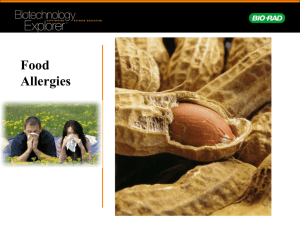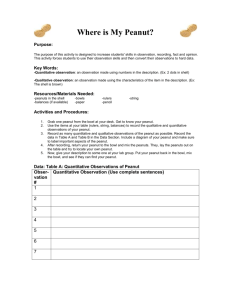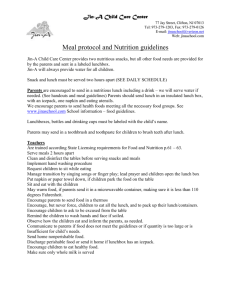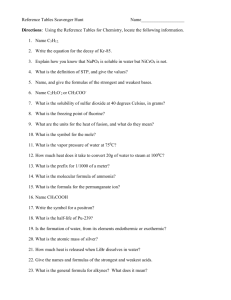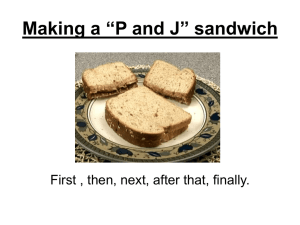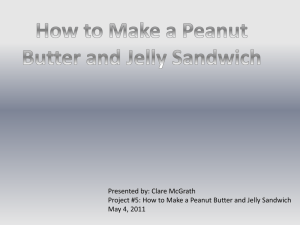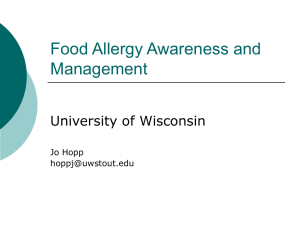Medical Report - WordPress.com
advertisement
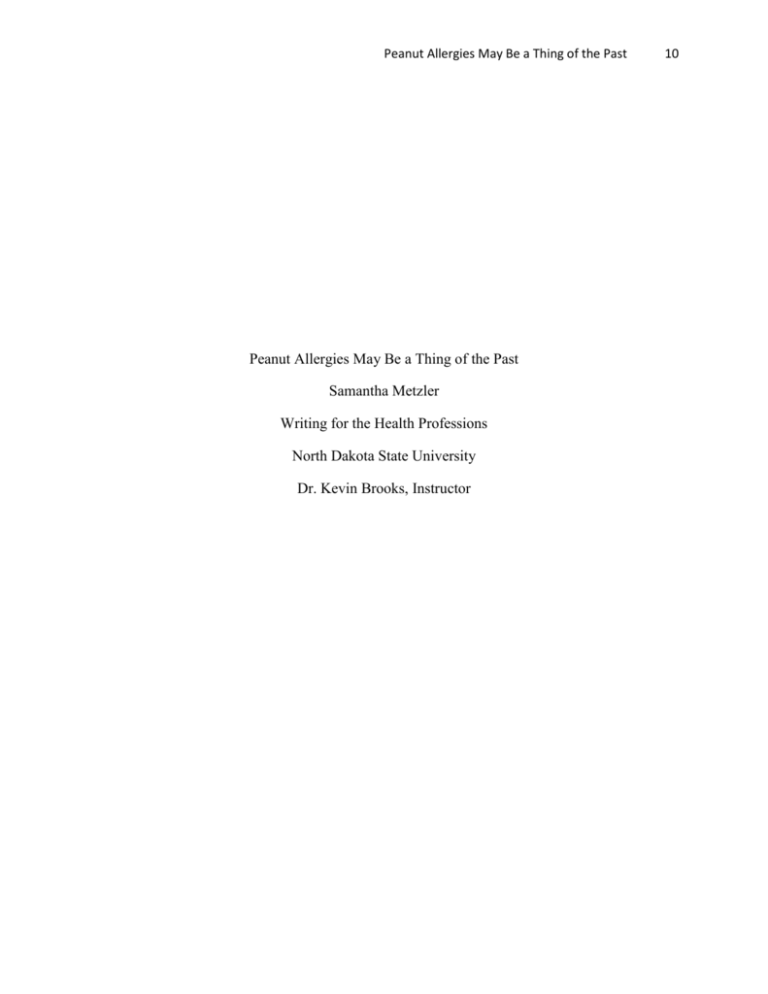
Peanut Allergies May Be a Thing of the Past Peanut Allergies May Be a Thing of the Past Samantha Metzler Writing for the Health Professions North Dakota State University Dr. Kevin Brooks, Instructor 10 Peanut Allergies May Be a Thing of the Past 10 Background Information In the United States, an estimated 12 million Americans suffer from various food allergies. Some of the common ones are milk, nuts, eggs, and seafood. 3.3 million of these people are estimated to be allergic to peanuts or tree nuts (Parker-Pope, 2009). According to a News story on ABC News, “peanut allergies are considered to be the most dangerous allergy and peanut reactions count for about 30,000 emergency room visits each year (2009). Reactions to peanuts can be triggered by the tiniest amount of peanut. Sometimes it is hard to determine whether or not some foods contain peanuts in them or not. Some companies have trace amounts of peanuts in their products that may be on their label. Since we are becoming aware of what peanut allergies can and why they have many manufacturers are printing, “may contain nuts” or “may contain trace amounts of nuts” on their labels. Allergic reactions are a way of your body telling you that there is something in you that shouldn’t be there. These substances are known as antigens. When your body detects an antigen your body triggers your immune system which helps protect your body and keeps you from getting sick. Your immune system consists of white blood cells that produce an antibody when it comes in contact with an antigen. The antibodies are there to destroy the invader (Allergic Reaction). “According to EMedicine Health symptoms of an allergic reaction include any, some, or many of these: Peanut Allergies May Be a Thing of the Past 10 Skin: redness, itching, swelling, blistering, weeping, crusting, rash, eruptions, or hives (itchy bumps or welts) Lungs: wheezing, tightness, cough, or shortness of breath Head: swelling of the face, eyelids, lips, tongue, or throat; headache Nose: stuffy nose, runny nose (clear, thin discharge), sneezing Eyes: red (bloodshot), itchy, swollen, or watery Stomach: pain, nausea, vomiting, diarrhea, or bloody diarrhea” The effects of an allergic reaction vary from person to person. In some people the reactions may be just a slight rash while others may have trouble breathing. One of the most common ways that a person can stay away from an allergic reaction is simply to avoid peanuts altogether. If you are unable to stay away from peanuts and you have a reaction there are some drugs that you may be able to use to help reduce symptoms. According to the Mayo Clinic you can inject adrenaline (epinephrine) into your system. Also you may take antihistamines such as Benadryl. Even after you take these drugs, you should still seek medical attention to make sure everything is okay (2008). Another upcoming way to cure peanut allergies is oral immunotherapy. Research studies are being done right not to determine if this treatment will be effective for the people with allergies. Oral immunotherapy is when you give someone “escalating doses of peanut protein, in the form of flour mixed into applesauce or other food.” (WebMD, 2007) The next few stories that I have will further discuss the studies about oral immunotherapy. Media Stories Peanut Allergies May Be a Thing of the Past 10 ABC News Health released a story in 2009 peanut allergies a therapy that may be able to treat it. The article was called, “Possible Therapy Takes Bite out of Peanut Allergy.” This article was based off of a study that was done by researchers at Duke University and Arkansas Children Hospital (2009). The study included twenty-nine children that were severely allergic to peanuts and they were given minute amounts of peanut flour to build their tolerance level. “After eight months to 10 months of gradual dose increases, most can eat the peanut-flour equivalent of 15 peanuts daily, said Wesley Burks, Duke’s Chief allergy chief.” (2009) This study has given hope to the millions of people who suffer from food allergies. One of the parent’s a participant was quoted as saying, “It’s such a burden lifted off your shoulder to realize you don’t have to worry about your child eating a peanut and ending up real sick.” At the beginning of this study her son couldn’t even tolerate 1/6 of a peanut with having an allergic reaction (2009). I think that this article does a good job of covering the basic on the study. It doesn’t go too in-depth on any of how the research was done. I think that this article does do a good job of reporting the medical facts. Many people who read news stories just want to read about the headlines. If a person wants to read more about a study they should be able to search the web just like we did for this assignment to find what they are looking for. On March 15, 2009 the New York Times released an article called, “Treatment for Peanut Allergies Shows Promise” (Parker-Pope) It was based on two studies that tried to show the potential for a cure for peanut allergies. “An estimated 12 million Americans suffer from food allergies, including about 2.2 million children. About 3.3 million people are allergic to peanuts or tree nuts. While drugs can be used to treat an allergic reaction, there are no approved treatments for food allergies.” (Parker-Pope, 2009) Peanut Allergies May Be a Thing of the Past 10 I believe that this article did a very good job at explaining what the study was determined to figure out. It gave good information on the people in the study and how their results ended up. It also told you how many people actually finished the study and how many people dropped out. Unlike the other articles they did a good job at not only describing the study but also the technical terms that went with study. For example they explained what immunotherapy was, some of the symptoms of a reaction and also other treatments. I think that the people that are doing this research believe that they are on to something good. They are looking to find more research participants and maybe with all of this publicity they will have more people willing to do the studies. The final article that I found about Oral Immunotherapy was from WebMD, a popular health website. The article was named, “Oral Immunotherapy May Desensitize Allergic Children; Skin Test May Predict Who Will Outgrow” (WebMD, 2007) “Small doses of peanut protein, given for months under medical supervision, can desensitize children with peanut allergy, reducing the risk of a reaction if they accidentally eat peanuts, according to a new study.” (WebMD, 2007) The article gave some background on the issue for example that about 1% of the U.S. population is affected by peanut allergies and that the easiest way to avoid a reaction is to avoid the food completely (WebMD, 2007). I think that this article would be great for the average person to read because it is so easy to read and understand. It didn’t use too many big words. If it did they explained what those words meant so you wouldn’t feel lost. The other articles were more on a scholarly level so it was difficult to read. The article did not discuss a lot of details about the study just how many people were in the studies and that they received increasing doses of peanut flour. Overall, I think this article was well written. Peanut Allergies May Be a Thing of the Past 10 Medical Studies Correspondents of Addenbrooke’s Hospital in Cambridge, UK conducted a study that “investigated whether peanut oral immunotherapy (OIT) can induce clinical tolerance to peanut protein: (Clark, 2009).There were only four male research participants in the study that were ages 9-13. Each of which has peanut allergies. At the beginning of the study each child underwent pre-intervention oral challenges to confirm that they had clinical allergies. They also tried to figure out the amount of allergen that was needed to cause a reaction (Clark, 2009). After the dosing amounts were figured out for child, daily doses were given to them to take. The doses increased from 5 to 800mg over six weeks of time. The study was a double blinded with a placebo control. Placebos and active peanut doses were given on different days of the study. As the boys became tolerant to the level of peanut that they were given the amount that they were given also went up. At the end of the study all of the boys completed their up-dosing to 800mg protein/day and stayed at that toleration level for six weeks. When the boys did their final open challenge three out of the four boys were able to eat approximately twelve peanuts worth of people protein. “One peanut contains approximately 150-200mg of protein.” (2009) The researchers finally concluded that with OIT a child may be able to tolerate amounts of peanuts that may be given in accidental dosing. They may not be able to eat a whole can of peanuts but they no longer have to worry about tiniest amount of peanuts. A downside to this is that if the child stops taking their daily doses of peanuts, the allergy may come back. The Peanut Allergies May Be a Thing of the Past 10 researchers also recommend more studies on this issue. They believe that in the future there may be a cure to allergies. I believe that this study isn’t very reliable. There were only four participants all of which were males. There was a very good selection of participants and it did not represent the population very well. To make the study more reliable they could have more participants with a variety of people. Even though the way the study played out, A.T. Clark is a credible source. He has an extensive background in allergy medicine. One of the things that the researchers emphasized to people was not to try this at home. It is dangerous for you to try the study at home because the amounts that they use are so minute we can’t get them small enough. This research study was funded by the National Institute of Health, the Food Allergy and Anaphylaxis Network, Food Allergy Project, Gerber Foundation and the Robins Family Foundation. On June 1997, the National Jewish Medical and Research Center released an article called, “Treatment of anaphylactic sensitivity to peanuts by immunotherapy with injections of aqueous peanut extract.” The article described a study that is similar the study that was conducted by A.T. Clark. It tried to conclude that immunotherapy may decrease the risk for allergic reactions to peanuts. One of the differences is that this study used injections of aqueous peanut extract instead of peanut flour. The way that they tested the study was by “giving twelve patients with immediate hypersensitivity to ingestion of peanuts.” (Nelson, 1997) This was a double-blind placebo-controlled study. It didn’t specify how the participants were chosen or even if they were male or female so the numbers may not represent a good population. In order to make the study more plausible half of the participants were given injections of the peanut extract Peanut Allergies May Be a Thing of the Past 10 while the other half were given placebos. Every participant was given these doses for 1 year. To test how they were doing, they also did oral challenges just like the previous study. The results of the study are also similar to the study conducted at the University of Arkansas. “All treated patients achieved the maintenance dose of 0.5ml of 1:100 wt/vol peanut extract by the rush injection protocol.” (Nelson, 1997) All of the participants completed the study and showed signs of improvement. At the end of the study the researchers concluded that the injections do increase the tolerance that patients can build. This study was funded by the National Institute of Allergy and Infectious Diseases (Nelson, 1997). I think that this study is a little outdated but I think that it was a stepping stone in the fight against peanut allergies. This study may have even been a reason why the people at Duke University and the University of Arkansas did their research. I think that they should try to find more participants that represent better populations of people. In the Journal of Allergy and Clinical Immunology in January 2007, an article was released called “Oral Peanut Immunotherapy for Peanut Allergic Patients.” It was based on a study that was used to “determine if peanut oral immunotherapy can desensitize peanut allergic subjects to peanut protein.” (Nash, 2007) There were only eight children that underwent the study. It did not mention their ages or the sex. Similar to other recent studies that have been done the study was done in phases. At the beginning the child was given an oral challenge to see how much peanut flour would cause a reaction. Next the child would get doses ranging from 0.1mg to 50mg and those doses would eventually increase as their tolerance grew. The final phase that they went through was the maintenance phase where the child kept taking a dose of peanut protein so they wouldn’t lose their tolerance level. Peanut Allergies May Be a Thing of the Past 10 The results were similar to the other studies in that the children did increase their tolerance to peanut flour. Out of the eight participants only one of them had a reaction that had to be treated with antihistamines. The researchers concluded that “peanut OIT is safe and effective for decreasing the risk of a significant reaction with peanut ingestion.” (Nash, 2007) This article did not say how the patients were chosen. It did not include vital information on the participants and how they reacted to the study. I think that they should use a significant amount of people to make the study more valid. I think the others are credible people it just doesn’t sound like they are because they don’t give enough detail about their study. After thoroughly reviewing the media and medical sources concerning the possible treatment of oral immunotherapy for peanut allergies I have come to some conclusions. The first one is that I think that the research being done on this issue may lead to the improvement of the lives of millions of people all over the world. The studies have shown to increase the tolerance level of most participants which would put them at lower risk for an allergic reaction. I also think that media sources are a good source of information. One way to know if you are getting good information is to look directly at the study that has been cited and look at the work those professionals have done. Also, you should always get your information from a credible source. Good websites to use are those from research facilities and professionals in the area of study you are looking for. These articles have also brought up questions about whether or not they can use this oral immunotherapy for other allergies. The media may have its hype but if you find the right source you can get all the facts. Peanut Allergies May Be a Thing of the Past 10 Work Cited Allergic Reaction. EMedicineHealth: Practical Guide to Health, Retrieved July 30, 2009, from http://www.emedicinehealth.com/allergic_reaction/page3_em.htm (April 14, 2008). The Anaphylaxis Campaign - providing support and information to people at risk from life-threatening allergic reactions. HSBC Amanah, Retrieved July 30, 2009, from http://optimistworld.com/Articles2.aspx?id=e84269d3-86f2-4cbb-8db5c24b2d1b6e8f&style=charities (Feb. 26, 2007 ). Beating Peanut Allergies. Retrieved August 5, 2009, from CBS News.com Web site: http://www.cbsnews.com/stories/2007/02/26/health/webmd/main2518819_page2.shtml?t ag=contentMain;contentBody Nash, S (2007). Oral Peanut Immunotherapy For Peanut Allergic Patients. The Journal of Allergy and Clinical Immunology, 119, Retrieved July 30, 2009, from http://www.jacionline.org/article/S0091-6749(06)03000-4/fulltext Parker-Pope, T (March 15, 2009 ). Treatment for Peanut Allergies Shows Promise. Retrieved July 30th, 2009, from The New York Times Web site: http://www.nytimes.com/2009/03/16/health/16peanuts.html (April 26, 2008). Peanut allergy. Mayo Clinic, Retrieved July 30, 2009, from http://www.mayoclinic.com/health/peanut-allergy/DS00710/DSECTION=treatmentsand-drugs Peanut Allergies May Be a Thing of the Past 10 2009). Possible Therapy Takes Bite out of Peanut Allergy. ABC News Health, Retrieved July 30, 2009, from http://a.abcnews.com/Health/WireStory?id=7086602&page=3


